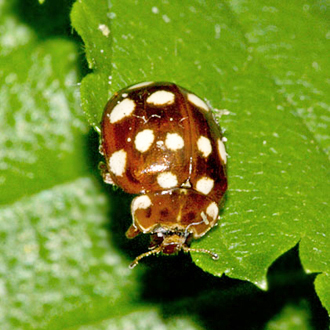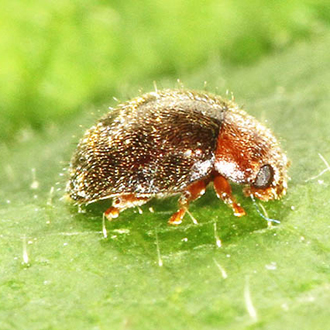

|
 |
 |
 |
 |
 |
 |
 |

|

|  |

|
 |
 |

|
|
Ladybirds (Coccinellidae) are widely viewed as the gardener's friend because of the damage many species do to aphids, regarded uniformly as one of the biggest enemies of anyone growing vegetables and flowers. Wasps certainly sort out large numbers of these small invertebrates but what sets Ladybirds apart is that they are mobile predators as both larvae and adults. The life cycle of the most commonly seen Ladybird, the Seven-spotted (Coccinella septempunctata, 6mm), generally sees a female lay up to 200 eggs beneath leaves close to colonies of aphids. The resulting larvae, which are a fair bit longer than the adults at around 11mm, forage ferociously for three weeks or so before pupating. As can be seen above, the emerging adult is yellow, developing the full red-and-black colouring a little later. Seven-spotted ladybirds, like all the others, are effective if slightly ungainly fliers and they last a long time, overwintering, often in large numbers, under tree bark or any other insulated and secure spot. Ladybirds have few predators since, as usual, the bold colouring they carry denotes danger, in this instance the fact that they taste unpleasant thanks to alkaloid poisons. Colour variation in individual species can be remarkable, and while the usual form of the Two-spotted Ladybird (Adalia bipunctata, 5mm) is mostly red with black spots, some are mostly black with red spots. Others are orange or yellow, and there can be more than two spots. In contrast, the Cream-spotted Ladybird (Calvia quatuordecimguttata, 5mm) is pretty much the same in appearance everywhere and the Fourteen-spotted Ladybird (Propylea quatordecimpunctata, 4mm) also doesn't show much variation, with yellow and black consistently shown. Equally, the amounts of each colour can vary greatly. Not all the 40-plus species in Britain eat invertebrates - the Orange Ladybird (Halyzia sedecimguttata, 4m) and Twenty-two spot Ladybird (Psyllobora 22-punctata, 4mm) are two that rely on fungus or mildew. These are not necessarily so helpful to gardeners since they can pick up parts of what they are feeding on, including spores, and unwittingly transfer them to other plants. The 22-spot is very common. Some Ladybirds are generalists in the flora they use for living and breeding, others are a tad more specific, such as the Larch Ladybird (Aphidecta obliterata) on conifers and the Pine Ladybird (Exochomus quadripustulatus, 3mm) and Cream-streaked Ladybird (Harmonia quadripunctata, 4mm). These are aphid eaters, though Pine Ladybird larvae also consume scale insects, and they all concentrate on evergreens. Despite the specific name, some Pine Ladybirds turned up in reasonable numbers in the garden in 2007 on Cherry Laurel (Prunus laurocerasus). The Eyed Ladybird (Anatis ocellata, 8mm) is one of the larger species and breeds The Ten-spot ladybird (Adalia 10-punctata, 6mm) is reasonably common and very variable in colour, unlike the Heather Ladybird (Chilocorus bipustulatus, 5mm), which has black with two red marks on the elytra. This species was in my garden in 2014 and 2015 but rarely on heather, spending time instead on such plants as Canterbury bells and Canadian goldenrod. There are a number of small species, mostly from the Scymnus genus, which are not always easy to identify. Scymnus haemorrhoidalis and Scymnus interruptus, both 3mm in length, are two of them. They are not uncommon but are so small that they must often not be noticed. The same comment applies to the Australian import Rhyzobius lophanthae (3mm), which seems to be be spreading across southern England. It feeds on scale insects. Now for the villain of the piece. As bright as any but much less welcome is the non-native Harlequin Ladybird (Harmonia axyridis succinea, 8mm). This species is spreading rapidly across the countryside and apparently poses a major threat to our native species, which it outscores in both size and productivity. There were almost 50 in my gazebo on one afternoon in October 2015. David Element explains the position with typical precision on his informative website www.david.element.ukgateway.net and has plenty of excellent images of the Harlequin Ladybird in its various colour forms as well, including the melanic forms Harmonia axyridis spectabilis and Harmonia axyridis conspicua. David writes: "These beetles are Asian in origin and they have been artificially introduced to the USA and several European countries as a form of biological pest control. It would appear that the consequences of earlier artificial introductions of alien species have either never been learned, poorly researched, or otherwise rashly dismissed by those responsible. "In the case of the Harlequin Ladybird there are doubtless sophisticated naturally occurring population control factors (e.g. predators, parasites, fungal, bacterial or viral diseases, prey species population cycles) which would keep the numbers in check in their own habitat. However, these same factors are not (yet) operational in the UK. It is highly likely that the parents of the first UK-bred generation have arrived by emigration from the northern coast of Belgium - although the arrival of some beetles in produce cannot be ruled out. "'The Harlequin' may be capable of producing at least three broods during a single season if conditions are favourable. This insect is predatory on the same prey items (aphids, etc.) as the native ladybird species, but unfortunately also on those useful insects which naturally control garden and crop pests themselves, namely lacewings, hoverfly larvae and other ladybirds. "If Harlequin Ladybirds become numerous (and they will) then the natural balance between these predator and prey species could be irreparably damaged." In 2008 in Surrey there was unwelcome evidence that Harlequin larvae eat butterfly caterpillars, in this instance Brimstone. Images © Jeremy Early. All rights reserved. In 2013 I published My Side of the Fence - the Natural History of a Surrey Garden. Details may be found, and orders placed, via this hyperlink My Side of the Fence. In November 2015 Surrey Wildlife Trust published the atlas Soldierflies, their allies and Conopidae of Surrey, jointly written by David Baldock and me. Details are on this web page: Atlas. |